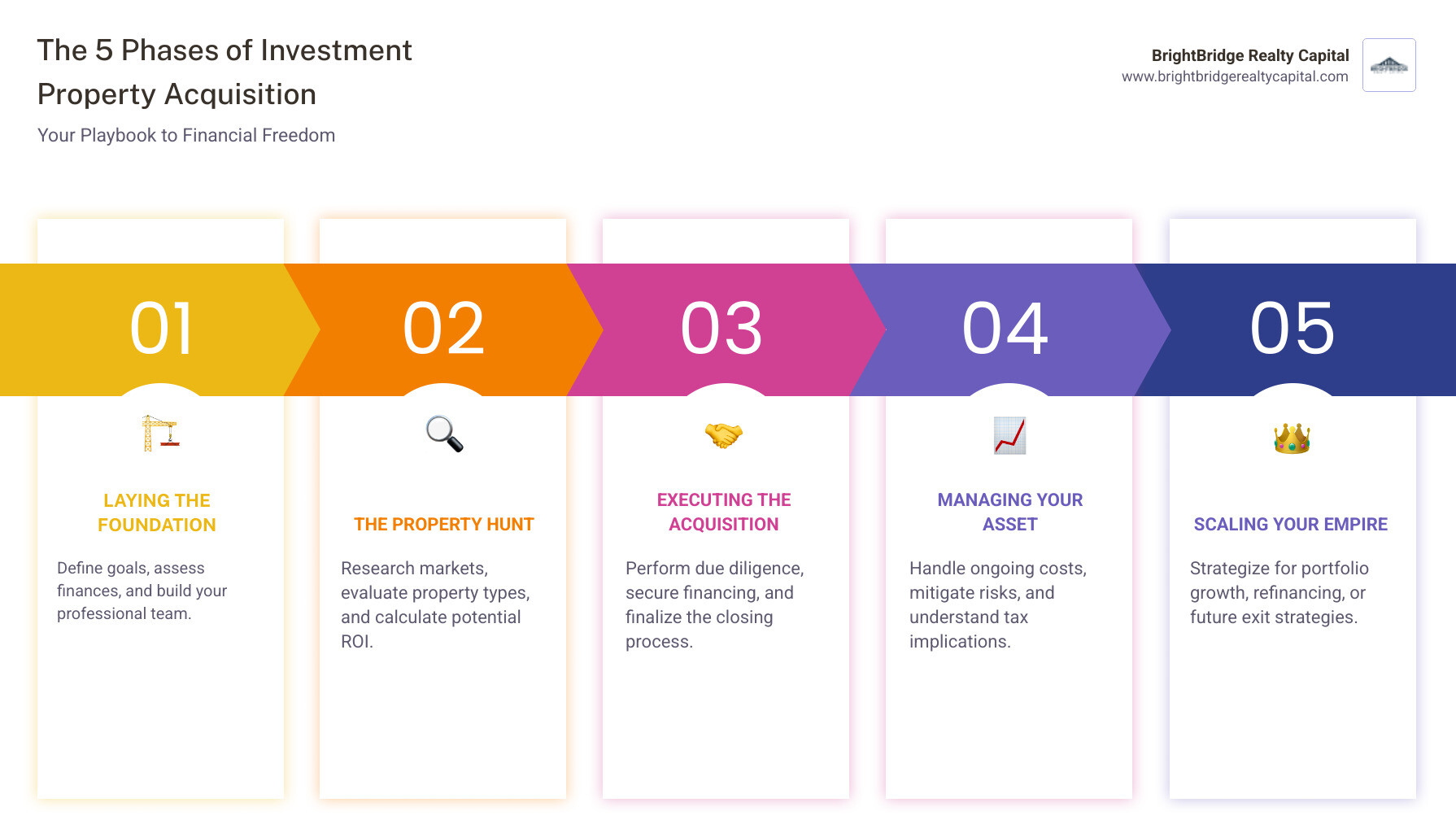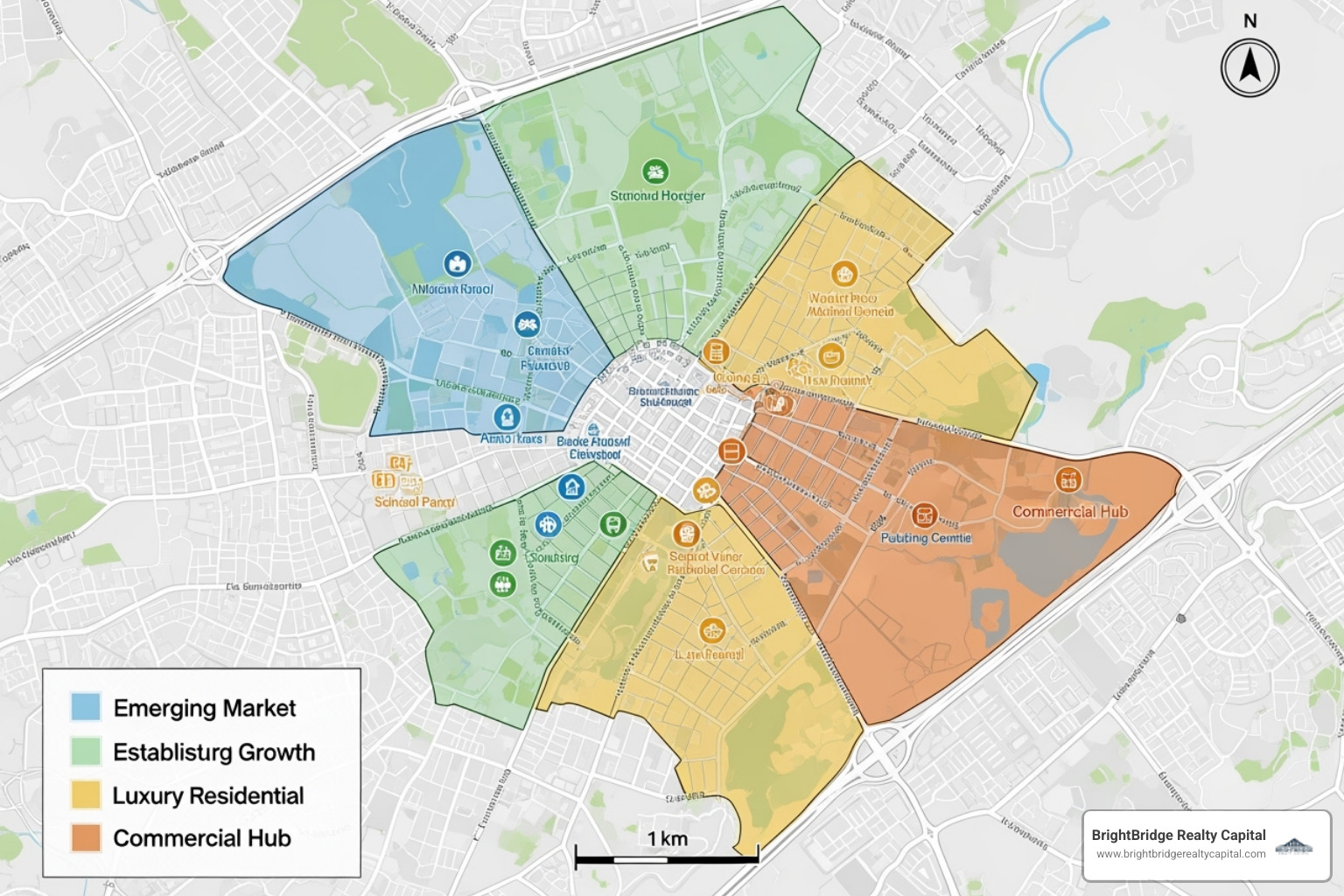From Asset to Empire: Your Investment Property Acquisition Playbook

Why Investment Property Acquisition Is Your Path to Financial Freedom
Investment property acquisition is the process of identifying, financing, and purchasing real estate to generate income or build wealth. Whether you're seeking monthly rental income, flipping properties, or building long-term equity, the core steps are defining goals, securing financing, finding the right property, and closing the deal.
Quick Answer: The 5 Phases of Investment Property Acquisition
- Laying the Foundation – Define goals, assess finances, build your team
- The Hunt – Research markets, evaluate properties, calculate ROI
- The Acquisition – Conduct due diligence, secure financing, close the deal
- Asset Management – Handle ongoing costs, mitigate risks, scale your portfolio
- Exit or Expand – Sell, refinance, or reinvest to grow your empire
Real estate investing is a strategic way to build wealth. Unlike stocks, investment properties are tangible assets that can generate steady cash flow from rental income while appreciating in value. However, many first-time investors are overwhelmed by down payments, financing, and market research.
With a clear roadmap, the acquisition process, which typically spans 6 to 9 months, becomes manageable. The core principle is simple: successful investors make informed decisions based on research and analysis, not emotion. They understand their numbers, know their markets, and have financing lined up before making an offer.
I'm Daniel Lopez, a loan officer at BrightBridge Realty Capital. I've guided dozens of investors through the complexities of investment property acquisition, from first-time buyers to experienced portfolios. My focus is helping investors structure loans that align with their strategy, whether it's a quick flip or a long-term rental.
This guide breaks down the acquisition process into manageable phases. You'll learn how to set clear goals, research markets, secure financing, and manage your properties for maximum returns, helping you avoid common pitfalls and build a portfolio that generates real wealth.

Phase 1: Laying the Foundation for Success
Before you start searching for properties, you need to prepare your finances, clarify your goals, and assemble a team of professionals. This foundational work is crucial for a successful investment property acquisition.

Define Your Primary Objective
Why are you buying this property? Your answer will shape every decision. Most investors fall into two main categories:
- Rental Income: These investors want steady cash flow each month after all expenses are paid. They focus on properties in areas with strong rental demand.
- Capital Appreciation: These investors bet on the property's value increasing significantly over time. They might buy in an up-and-coming neighborhood or a fixer-upper, focusing on the profit from a future sale.
Many successful investors aim for both, but having a primary objective helps maintain focus.
| Strategy Type | Primary Goal | Typical Property Focus | Key Considerations |
|---|---|---|---|
| Buy and Rent (Cash Flow) | Steady Income | Multi-unit, single-family homes in rental-heavy areas | High occupancy rates, strong local economy, manageable expenses, effective property management |
| Buy and Hold (Appreciation) | Long-Term Value Growth | Properties in growing markets, fixer-uppers, land | Market trends, development plans, renovation costs, exit strategy (when to sell) |
Financial Preparedness and Initial Costs
Real estate investing requires significant upfront capital. Understanding these costs is essential.
- Down Payment: Lenders typically require at least 20% down for investment properties. On a $400,000 property, that's $80,000.
- Closing Costs: Budget 2-5% of the purchase price for fees like loan origination, appraisal, title insurance, and attorney fees. This could be $8,000 to $20,000 on a $400,000 property.
- Renovation Budget: If the property needs work, create a realistic budget and add a 20% contingency for unexpected issues.
- Contingency Fund: Keep three to six months of expenses (mortgage, taxes, insurance) in reserve for unexpected repairs or vacancies.
One common strategy is leveraging home equity. If you own a home, you may be able to use a home equity loan or line of credit to fund the down payment on an investment property.
Assembling Your Professional Team
Successful real estate investing is a team sport. Assemble these professionals before you start your search:
- Real Estate Agent: Find an agent who specializes in investment properties and understands local rental markets.
- Mortgage Specialist/Lender: This expert will help you understand financing options and get pre-approved. At BrightBridge Realty Capital, we specialize in fast, flexible funding for investors.
- Home Inspector: A thorough inspection can save you thousands in future repairs and provides leverage for negotiations.
- Accountant/Tax Advisor: A real estate-savvy accountant helps you maximize deductions and structure ownership for tax efficiency.
- Real Estate Attorney: An attorney reviews contracts and protects your legal interests during the closing process.
- Contractors & Property Manager: Depending on your strategy, you'll need reliable contractors for renovations and possibly a property manager to handle daily operations.
Building this team early allows you to move quickly when you find the right deal.
Phase 2: The Hunt for the Perfect Property
With your foundation in place, it's time to find a property that matches your goals and budget. This phase is about smart research and strategic evaluation.

Researching and Selecting a Market
Location is paramount in real estate. Before looking at specific properties, analyze potential markets based on these key factors:
- Market Conditions: Is it a buyer's or seller's market? Current trends in property values and rental rates will impact your negotiating power and returns.
- Population and Job Growth: Growing areas signal increasing demand for housing, which supports both rental income and appreciation.
- Rental Demand and Vacancy Rates: Look for markets with high demand and low vacancy rates (ideally below 5%) to ensure your property stays occupied.
- Property Taxes: High property taxes can erode cash flow, so factor them into your calculations from the start.
- Local Amenities and Infrastructure: Proximity to schools, transportation, shopping, and parks boosts property value and tenant appeal.
- Crime Rates: Safe neighborhoods attract quality tenants and protect property value. Check local police data and crime mapping tools.
- Demographics: Understanding the local population (e.g., students, families, professionals) helps you choose a property type that meets tenant needs.
Evaluating Property Types
Different properties suit different investment strategies. Match the property type to your goals and management tolerance.
- Single-Family Homes: A popular starting point, often attracting long-term family tenants. However, a single vacancy means a 100% loss of income.
- Multi-Unit Properties (2-4 Units): Duplexes, triplexes, and fourplexes offer multiple income streams, mitigating vacancy risk. They provide economies of scale for maintenance but require more management.
- Apartment Complexes (5+ Units): These offer significant scale and income potential but require a larger investment and more complex management. For a deeper dive, see our guide on evaluating apartment complexes for investment.
How to Evaluate Potential ROI
This is where math replaces emotion. Running the numbers is critical to a successful investment property acquisition. A common quick-screen tool is the 1% Rule, which suggests that a property's monthly rent should be at least 1% of its purchase price. While not a substitute for deep analysis, it helps quickly filter out underperforming deals.
- Potential Rental Income: Research comparable properties ("comps") on sites like Zillow, Rentometer, or by consulting your real estate agent to establish a conservative estimate of monthly rent.
- Cash Flow Analysis: Subtract all potential expenses from your gross rental income. A comprehensive list of expenses includes the mortgage principal and interest (P&I), property taxes, insurance, a vacancy allowance (typically 5-10% of rent), property management fees (8-12%), and funds for both routine maintenance and larger capital expenditures (CapEx) like a new roof or HVAC system. Positive cash flow is your monthly profit.
- Net Operating Income (NOI): This is the property's income after all operating expenses but before mortgage payments (debt service). NOI = Gross Rental Income - All Operating Expenses. Operating expenses include taxes, insurance, management, utilities paid by the owner, maintenance, and vacancy loss. It's a key metric for comparing the raw profitability of properties regardless of financing.
- Capitalization Rate (Cap Rate): Calculated as NOI divided by the purchase price (Cap Rate = NOI / Price). This percentage helps you compare the potential return of different properties. Higher cap rates can indicate higher returns but often come with higher risk.
- Cash-on-Cash Return: This measures the annual pre-tax cash flow against the total cash you invested (down payment, closing costs, initial repairs). It shows the return on your actual out-of-pocket investment and is a powerful metric for understanding the efficiency of your capital.
If the numbers don't work, move on. A bad investment is harder to recover from than a missed opportunity.
Phase 3: Executing the Investment Property Acquisition
Once you've found a promising property and the numbers work, it's time to make it yours. This phase is about executing a proven process to protect your investment.

Key Steps in the Investment Property Acquisition Process
The purchase process involves several critical steps:
- Property Inspection: This is essential. A licensed inspector identifies hidden issues, and their report can be used to negotiate repairs or a price reduction.
- Title Search: Verifies the seller's legal right to sell and uncovers any liens or ownership disputes. Title insurance protects you from future claims.
- Legal Document Review: Your real estate attorney will review the purchase agreement and other contracts to ensure the terms protect your interests.
- Purchase Agreement: This legally binding contract outlines the price, closing date, and contingencies (e.g., financing, inspection), which act as your safety nets.
- Final Walkthrough: Within 24 hours of closing, you'll verify the property's condition and ensure any agreed-upon repairs are complete.
- Closing (Settlement): Ownership is officially transferred. You'll sign documents, transfer funds, and receive the keys.
Financing Your Investment Property Acquisition
Securing financing is often the most intimidating part of investment property acquisition, but organization makes it smoother. Lenders view investment properties as higher risk, so they require more documentation.
Be prepared to provide:
- Proof of Income: Recent tax documents (like a Notice of Assessment) and, if you own other rentals, your T776 (Statement of Real Estate Rentals).
- Property Income Verification: Current lease agreements or an appraiser's opinion of market rent to show the property can cover its expenses.
- Credit History: Most lenders look for a FICO score of 740 or higher for the best rates.
- Debt-to-Income (DTI) Ratio: A lower DTI ratio improves your approval odds.
- Proof of Assets: Bank and investment statements showing you have funds for the down payment and reserves.
At BrightBridge Realty Capital, we provide customized rental property loans with fast closings, often within a week. As direct lenders, we offer competitive rates and a seamless process to help you secure deals quickly.
Understanding Financing Differences
Financing an investment property is different from buying a primary home.
- Down Payment: Expect to put down at least 20%, significantly more than the 3.5-5% often required for a primary residence. Some loan products may require 25-30% depending on the property type and your credit profile.
- Interest Rates: Rates are typically 0.5% to 0.75% higher for investment properties, but the interest is a tax-deductible business expense.
- Qualification Criteria: The process is more rigorous. Lenders evaluate both your personal income and the property's income-generating potential.
Specialized products like DSCR (Debt Service Coverage Ratio) loans can be a great option. These loans qualify you based on the property's cash flow rather than your personal income, offering more flexibility for investors. The DSCR is calculated by dividing the property's Net Operating Income (NOI) by its total annual debt service (mortgage payments). For example, if a property has an NOI of $20,000 and annual mortgage payments of $16,000, the DSCR is 1.25 ($20,000 / $16,000). Most lenders look for a DSCR of 1.2x or higher, proving the property can comfortably cover its own debt with a cushion.
Getting pre-approved for financing is essential. It tells you what you can afford and shows sellers you are a serious, prepared buyer, giving you a competitive edge.
Phase 4: Managing Your Asset and Scaling Your Empire
Congratulations on closing! Now, your investment property acquisition transforms from a transaction into an income-generating asset. This phase is about effective management and strategic growth.

Ongoing Costs and Responsibilities
Owning an investment property requires active management of costs and responsibilities.
- Property Management: Hiring a manager typically costs 8-12% of monthly rent but saves you time and handles tenant screening, rent collection, and maintenance calls.
- Maintenance and Repairs: Budget 1-2% of the property's value annually for both routine upkeep and unexpected repairs.
- Property Taxes and Insurance: These are significant ongoing expenses. You'll need specific landlord insurance, which covers liability and loss of rental income.
- Tenant Management: If self-managing, you are responsible for screening tenants, creating lease agreements, collecting rent, and handling all issues.
Effective property management is key to long-term success and profitability.
Understanding and Mitigating Risks
Every investment has risks, but they can be managed with proactive strategies.
- Property Vacancies: A vacant property generates no income but still has costs. Minimize this risk by:
- Thorough Tenant Screening: Conduct background checks, verify employment, and check references.
- Competitive Rent Pricing: Price your property based on local market rates to attract tenants quickly.
- Excellent Maintenance: A well-kept property encourages tenant retention.
- Proactive Renewals: Reach out to good tenants early to renew their leases.
- Market Risk: Property values and rental rates can fluctuate. Diversifying your portfolio across different markets or property types can help mitigate this.
- Liquidity: Real estate is not a liquid asset. Selling can take months, so maintain adequate cash reserves for emergencies.
- Tenant Issues: Late payments, property damage, and evictions are potential headaches. A strong lease agreement and professional property management can provide a buffer.
- Unexpected Expenses: Always maintain a contingency fund (3-6 months of expenses) to cover major repairs like a new roof or HVAC system without derailing your finances.
Tax Implications and Portfolio Diversification
Investment properties offer powerful tax advantages that can boost your returns. Work with a tax advisor to maximize these benefits.
- Deductible Expenses: You can deduct mortgage interest, property taxes, insurance, and costs for maintenance and repairs.
- Depreciation: This is a significant non-cash deduction. The IRS allows you to depreciate the value of a residential rental property (excluding land) over 27.5 years. This reduces your taxable income, even if the property's value is increasing.
Real estate also plays a crucial role in portfolio diversification. As a tangible asset, it often performs differently than stocks and bonds, providing stability and a hedge against inflation. As rental income and property values tend to rise with inflation, real estate can protect your purchasing power.
As you scale your portfolio, a reliable financing partner is vital. At BrightBridge Realty Capital, our fast and flexible rental property loans are designed to help investors grow efficiently. Our ability to close in as little as a week gives you the competitive edge needed to secure great deals.
Frequently Asked Questions about Investment Property Acquisition
What are the primary benefits vs. the significant drawbacks of owning an investment property?
Understanding both sides of investment property acquisition is key.
Benefits:
- Steady Cash Flow: Consistent income from monthly rent.
- Appreciation: Potential for the property's value to increase over time.
- Tax Benefits: Deductions for mortgage interest, property taxes, and depreciation.
- Leverage: Using a mortgage to control a large asset with a smaller initial investment, amplifying returns.
- Inflation Hedge: Rental income and property values tend to rise with inflation.
Drawbacks:
- High Initial Costs: Requires a significant down payment (20%+) and closing costs.
- Ongoing Management: It's not passive income; it requires time and effort for maintenance and tenant issues.
- Vacancy Risk: An empty property generates no income but still has expenses.
- Low Liquidity: Real estate cannot be converted to cash quickly.
- Market Risk: Property values can decline during economic downturns.
How do I mitigate the risk of property vacancies?
Minimizing vacancies is crucial for profitability. Key strategies include:
- Thorough Tenant Screening: Implement a rigorous process with background checks, credit reports, and landlord references.
- Competitive Rent Pricing: Research the local market to set a rent that is attractive to tenants but still profitable.
- Excellent Property Maintenance: Keep the property in great condition to retain good tenants and attract new ones.
- Desirable Amenities: Offer features like in-unit laundry, updated appliances, or a pet-friendly policy to stand out.
- Proactive Lease Renewals: Contact good tenants a few months before their lease expires to encourage them to stay.
What are the differences in accounting for investment property acquisitions under IFRS vs. ASPE?
This is a technical distinction for businesses following specific accounting standards.
IFRS (International Financial Reporting Standards): Uses a dedicated standard (IAS 40) for investment property. After initial recognition at cost, it allows a choice between the cost model (cost less depreciation) or the fair value model (re-measuring to current market value each period, with changes affecting profit/loss).
ASPE (Accounting Standards for Private Enterprises): Does not have a separate standard. Investment property is accounted for under general property rules (Section 3061) using only the cost model (cost less accumulated depreciation).
In short, IFRS offers more flexibility with the fair value option, while ASPE mandates a simpler, cost-based approach. For more details, it's best to learn more about accounting standards and consult with a professional accountant.
Conclusion
Investment property acquisition is more than a transaction; it's a strategic path toward financial freedom. By following a clear roadmap—from setting goals and securing financing to managing your asset—you can build a portfolio that generates long-term wealth.
The key to success is making informed decisions based on research and analysis, not emotion. While real estate offers incredible benefits like cash flow, appreciation, and tax advantages, it also comes with challenges like high upfront costs and management responsibilities.
You don't have to steer this journey alone. A team of professionals—including a real estate agent, an accountant, and a reliable financing partner—is essential for confident decision-making.
In real estate, timing is critical. When a great opportunity arises, you must act fast. Having financing ready gives you a powerful competitive edge. For investors who need to move quickly, the rental property loans from BrightBridge Realty Capital offer a solution. As direct lenders, we specialize in fast closings, often within a week, empowering you to seize time-sensitive deals without the delays of traditional banks.
With the right knowledge, team, and financing, you can move from analyzing your first deal to building a real estate empire. The path is clear—now is the time to take the next step.


